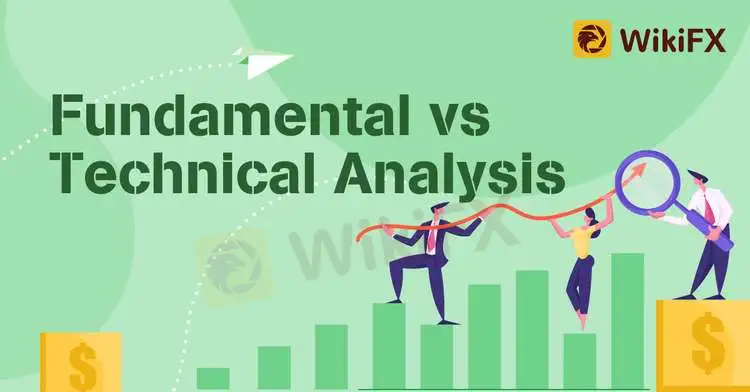Fundamental vs Technical Analysis
Abstract:Fundamental and technical analysis play some of the most influential and critical roles in making trading decisions amongst traders today. They are widely accepted by stock, foreign exchange, indices and cryptocurrency traders worldwide. Traders use either or both of the methods to make key trading decisions in their respective markets.

Fundamental and technical analysis play some of the most influential and critical roles in making trading decisions amongst traders today. They are widely accepted by stock, foreign exchange, indices and cryptocurrency traders worldwide. Traders use either or both of the methods to make key trading decisions in their respective markets.
Fundamental analysis refers to global economic news or events and how they affect the financial markets. These news event may be political, social, economic, Federal policy change and company earnings. They include the Gross Domestic Product (GDP), Interest Rates, Trade Balance, Retail Sales Index, The Producer Price Index (PPI), Consumer Price Index (CPI), Employment Indicators, Durable Goods Orders and Housing Data. Technical analysis focuses on price movement of a market and use this information to make predictions about possible future price direction. Technical analysts believe that world events are factored into price and such events are readily visible by analyzing it.

It is important to note that technical analysis plays a very significant and ignoble role in making trading decisions. It clearly reveals horizontal levels of support and resistance which are clearly significant. Furthermore, it is pertinent to note that markets often and usually react opposite to what an impending news event implies. Nevertheless, there are times when the market moves in the direction implied by a news event. Another vilifying fact about fundamental analysis is that it's almost impossible to build a consistent trading strategy and trading plan around it. Unfortunately, it is widely accepted because markets operate largely on future possibilities. Technical analysis provides a more coherent, consistent and reliable approach to trade the financial markets profitably as compared to fundamental analysis. If fundamental analysis must be used, then it is advisable to consider it alongside technical analysis to clear inconsistencies before making important trading decisions.
Technical versus fundamental analysis in forex is a widely debated topic. There is no right answer to the question of which type of analysis is better and traders tend to adopt one, or a combination of the two, in their analysis. Enhance your forex trading. If you are new to forex trading, download the WikiFX app.

Read more

Key Forex Strategies
New to forex trading and looking for simple and effective trading strategies? We got you covered! In this quick guide, we'll explain some of the key forex strategies which are easy to digest. So, let's start!

Going Short of JPY Is Boosted by Yellen’s Remark on Interest-Rate Hikes Again
When interviewed by Bloomberg, Yellen, the U.S. Treasury Secretary, indicated that the USD 4-trillion budget released by Biden would be beneficial to America even if it may increase inflation and interest rates.

Brent oil is predicted of bullish repricing by Goldman Sach
According to Goldman Sachs' head of energy research, a nuclear deal between the U.S. and Iran could send energy prices higher - even if it means more supply in the oil markets. Talks are ongoing in Vienna between Iran and the six world powers - the U.S., China, Russia, France, U.K., and Germany - trying to salvage the 2015 landmark deal. Officials say there's been progress, but the conclusion of the negotiations remains unclear and oil prices have been soaring as a result.

EUR/USD Preview of the new week: US-China Trade Talks May Signal Wake-up Call
The European currency paired with the US dollar is mostly in one place in the last three weeks. It is despite the impressive drop this Thursday. It can not be called a classic flat. However, the quotes are in a minimal range. At the same time, the pair corrected slightly against the last round of the upward movement. However, this correction is very weak.
WikiFX Broker
Latest News
Year of the Fire Horse 2026: Which Zodiac Signs Have the Strongest Money Luck in Trading?
Stop Trading: Why "Busy" Traders Bleed Their Accounts Dry
Stop Chasing Green Arrows: Why High Win Rate Strategies Are Bankrupting You
Should You Delete Every Indicator from Your Charts? Let’s Talk Real Trading
Is ZarVista Legit? A Critical Review of Its Licenses and Red Flags
Scam Victims Repatriated: Malaysia Thanks Thailand’s Crucial Help
Why You’re a Millionaire on Demo but Broke in Real Life
Cabana Capital Review 2025: Safety, Features, and Reliability
XTB Review 2025: Pros, Cons and Legit Broker?
Voices of the Golden Insight Award Jury | Dennis Yeh, Head of Asia Pacific Region at Taurex
Rate Calc

